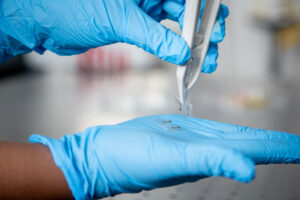2021/4/14 アメリカ合衆国・バッファロー大学
・ バッファロー大学が、水処理アプリケーションで繰り返し利用可能な耐久性を備える、3D プリント作製したグラフェンエアロゲルの概念実証を報告。
・ エアロゲルは、ゲル中の液体を気体に置き換えた軽量で多孔質の固体。超軽量で多孔質だが頑丈で弾力性のある発泡スチレンと同様の構造を有する。
・ 六角形の格子構造に炭素原子が並んだシート状物質のグラフェンは、水に含まれる汚染物質を除去する機能に優れているが、商業利用のレベルには至っていない。
・ ポリドーパミン(ムール貝の接着性分泌物に似た PDA として知られる合成材料)およびウシ血清アルブミン(BSA: ウシの血清から精製したタンパク質)の、自然から着想を得た 2 種類のポリマーを添加することで、適切な粘稠度のグラフェンベースインクを作製した。
・ グラフェンエアロゲルの試験では、米国の飲料水システムで問題となっている鉛やクロム等の重金属の除去を確認。さらに、カチオン性メチレンブルーやアニオン性エバンスブルー等の有機染料、ヘキサンやトルエンのような有機溶媒も除去。
・ また、有機溶媒処理を 10 回繰り返す試験では毎回溶媒を 100%除去し、再利用が可能であることを実証。メチレンブルー除去では、3 回目の後に除去能力の 2~20%の低減を確認した。
・ グラフェンエアロゲルのサイズはスケールアップ可能なため、大規模生産や下水処理場のような大型施設でも利用できる。ある場所で使用したエアロゲルを、水中に残留物質を残さずに取り外して別の場所で再利用することもできる。
・ 同大学とピッツバーグ大学による別のプロジェクトでは、分解が極めて困難なため「永遠の化学物質」として知られている有毒性物質のパー・ポリフルオロアルキル化合物(PFAS)を分解する手法やツールを開発している。
・ グラフェン以外のナノ金属粒子をエアロゲルに取り入れ、触媒としての機能の利用も可能。エアロゲルの壁面や表面に埋め込んだナノ金属粒子による生物・化学の両種汚染物質の劣化・分解が将来的な目標。
・ 同グラフェンエアロゲルについて特許出願中。商業化に向けて産業パートナーを探している。
URL: https://www.buffalo.edu/news/releases/2021/04/007.html
<NEDO海外技術情報より>
(関連情報)
Environmental Science: Nano 掲載論文(アブストラクトのみ:全文は有料)
Emerging investigator series: 3D printed graphene-biopolymer aerogels for water contaminant
removal: a proof of concept
URL: https://pubs.rsc.org/en/content/articlelanding/2021/EN/D0EN00953A#!divAbstract
Abstract
Graphene-based 3D macroscopic aerogels with their hierarchical porous structures and mechanical strength have been widely explored for removing contaminants from water. However, their large-scale manufacturing and application in various water treatment processes are limited by their scalability. In this study, we report a proof-of-concept direct ink writing (DIW) 3D printing technique and subsequent freeze-drying to prepare graphene-biopolymer aerogels for water treatment. To provide appropriate rheology for DIW printability, two bio-inspired polymers, polydopamine (PDA) and bovine serum albumin (BSA), were added to the graphene-based ink. The biopolymers also contributed to the contaminant removal capacity of the resultant graphene-polydopamine-bovine serum albumin (G-PDA-BSA) aerogel. The physicochemical properties of the aerogel were thoroughly characterized from the nano- to macroscale. The 3D printed aerogel exhibited excellent water contaminant removal performance for heavy metals (Cr(VI), Pb(II)), organic dyes (cationic methylene blue and anionic Evans blue), and organic solvents (n-hexane, n-heptane, and toluene) in batch adsorption studies. The electrostatic interaction dominated the removal of heavy metals and dyes while the hydrophobic interaction dominated the removal of organic solvents from water. Moreover, the aerogel showed superb regeneration and reuse potential. The aerogel removed 100% organic solvents over 10 cycles of regeneration and reuse; additionally, the removal efficiencies for methylene blue decreased by 2–20% after the third cycle. The fit-for-design 3D printed aerogel was also effectively used as a bottle-cap flow-through filter for dye removal. The potential and vision of the 3D printing approach for graphene-based water treatment presented here can be extended to other functional nanomaterials, can enable shape-specific applications of fit-for-purpose adsorbents/reactors and point-of-use filters, and can materialize the large-scale manufacturing of nano-enabled water treatment devices and technologies.




